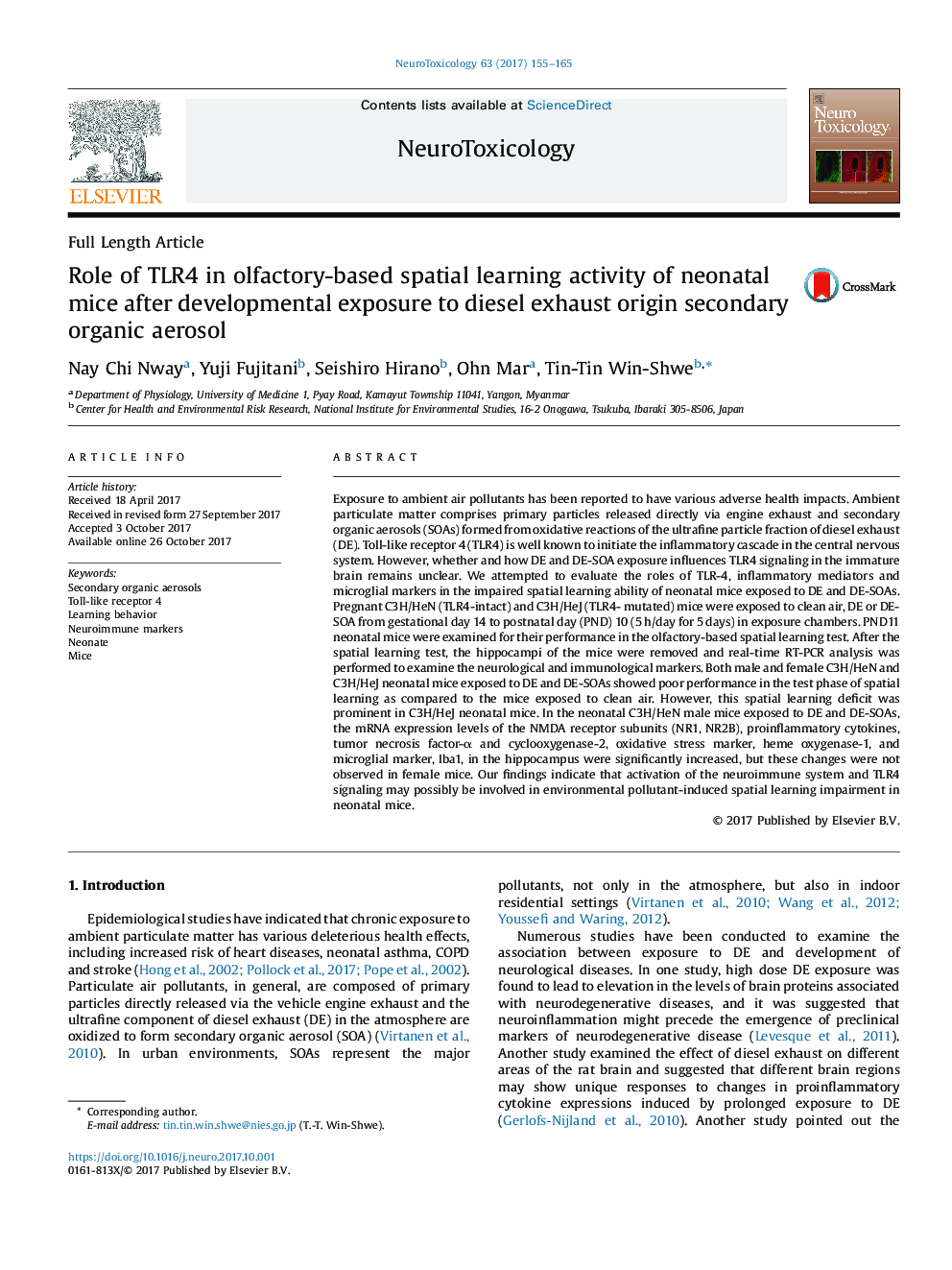| کد مقاله | کد نشریه | سال انتشار | مقاله انگلیسی | نسخه تمام متن |
|---|---|---|---|---|
| 8550415 | 1562031 | 2017 | 11 صفحه PDF | دانلود رایگان |
عنوان انگلیسی مقاله ISI
Role of TLR4 in olfactory-based spatial learning activity of neonatal mice after developmental exposure to diesel exhaust origin secondary organic aerosol
دانلود مقاله + سفارش ترجمه
دانلود مقاله ISI انگلیسی
رایگان برای ایرانیان
کلمات کلیدی
موضوعات مرتبط
علوم زیستی و بیوفناوری
علوم محیط زیست
بهداشت، سم شناسی و جهش زایی
پیش نمایش صفحه اول مقاله

چکیده انگلیسی
Exposure to ambient air pollutants has been reported to have various adverse health impacts. Ambient particulate matter comprises primary particles released directly via engine exhaust and secondary organic aerosols (SOAs) formed from oxidative reactions of the ultrafine particle fraction of diesel exhaust (DE). Toll-like receptor 4 (TLR4) is well known to initiate the inflammatory cascade in the central nervous system. However, whether and how DE and DE-SOA exposure influences TLR4 signaling in the immature brain remains unclear. We attempted to evaluate the roles of TLR-4, inflammatory mediators and microglial markers in the impaired spatial learning ability of neonatal mice exposed to DE and DE-SOAs. Pregnant C3H/HeN (TLR4-intact) and C3H/HeJ (TLR4- mutated) mice were exposed to clean air, DE or DE-SOA from gestational day 14 to postnatal day (PND) 10 (5 h/day for 5 days) in exposure chambers. PND11 neonatal mice were examined for their performance in the olfactory-based spatial learning test. After the spatial learning test, the hippocampi of the mice were removed and real-time RT-PCR analysis was performed to examine the neurological and immunological markers. Both male and female C3H/HeN and C3H/HeJ neonatal mice exposed to DE and DE-SOAs showed poor performance in the test phase of spatial learning as compared to the mice exposed to clean air. However, this spatial learning deficit was prominent in C3H/HeJ neonatal mice. In the neonatal C3H/HeN male mice exposed to DE and DE-SOAs, the mRNA expression levels of the NMDA receptor subunits (NR1, NR2B), proinflammatory cytokines, tumor necrosis factor-α and cyclooxygenase-2, oxidative stress marker, heme oxygenase-1, and microglial marker, Iba1, in the hippocampus were significantly increased, but these changes were not observed in female mice. Our findings indicate that activation of the neuroimmune system and TLR4 signaling may possibly be involved in environmental pollutant-induced spatial learning impairment in neonatal mice.
ناشر
Database: Elsevier - ScienceDirect (ساینس دایرکت)
Journal: NeuroToxicology - Volume 63, December 2017, Pages 155-165
Journal: NeuroToxicology - Volume 63, December 2017, Pages 155-165
نویسندگان
Nay Chi Nway, Yuji Fujitani, Seishiro Hirano, Ohn Mar, Tin-Tin Win-Shwe,